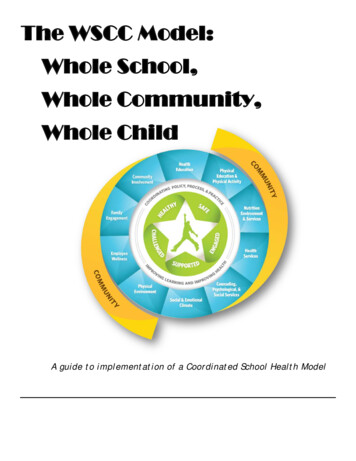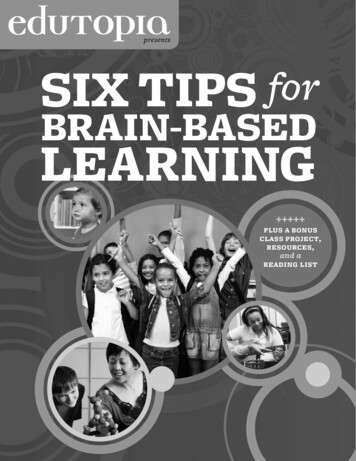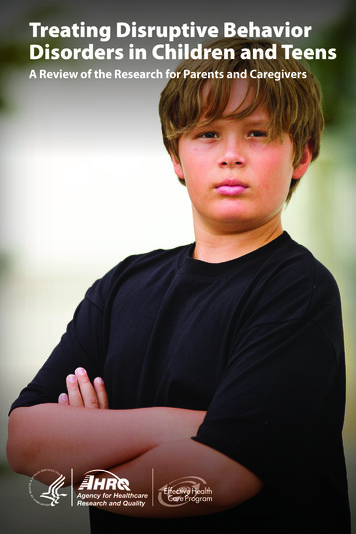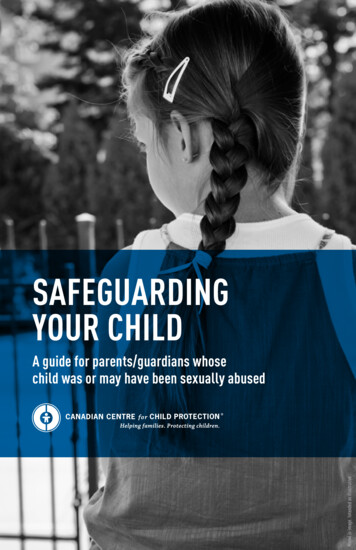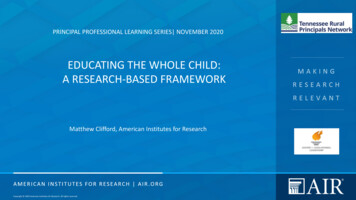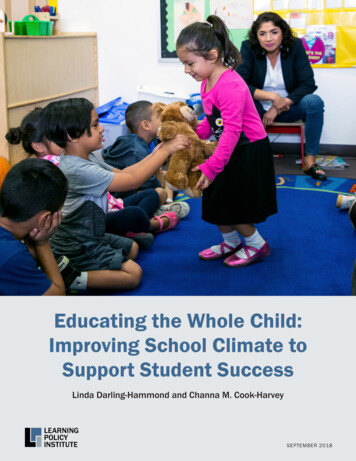
Transcription
Educating the Whole Child:Improving School Climate toSupport Student SuccessLinda Darling-Hammond and Channa M. Cook-HarveySEPTEMBER 2018
Educating the Whole Child:Improving School Climate toSupport Student SuccessLinda Darling-Hammond and Channa M. Cook-Harvey
AcknowledgmentsThe authors would like to thank Castle Redmond and Jennifer Chheang at the California Endowment for theirthoughtful guidance and input into this report. We also benefited from the feedback of a number of Californiaeducators, researchers, community organization leaders, and advocates, including Teiahsha Bankhead,Restorative Justice for Oakland Youth; Joseph Bishop, Center for the Transformation of Schools at UCLA;Dwight Bonds, California Association of African-American Superintendents and Administrators; Susan Bonilla,Council for a Strong America; Raymond Colmenar, The California Endowment; Sean Darling-Hammond,University of California, Berkeley; Joyce Dorado, University of California, San Francisco; Laura Faer, PublicCounsel Law Center; Sophie Fanelli, Stuart Foundation; Liz Guillen, Public Advocates; Jessica Gunderson,Partnership for Children & Youth; Thomas Hanson, WestEd; Heather Hough, Policy Analysis for CaliforniaEducation; Taryn Ishida, Californians for Justice; Debbie Lee, Futures Without Violence; Sergio Luna, PICOCalifornia; Brent Malicote, Sacramento County Office of Education; Kim Mecum, Fresno Unified SchoolDistrict; Mary Perry, California State PTA; Glen Price, California Department of Education; Ryan Smith, TheEducation Trust–West; Elisha Smith Arrillaga, The Education Trust–West; Brad Strong, Children Now; SylviaTorres-Guillén, ACLU of Southern California; and David Washburn, EdSource.We appreciate LPI colleagues Lisa Flook, Roberta Furger, and Hanna Melnick for providing background researchand input to this report, and Charlie Thompson for her expert help with references and citations. In addition,thanks are due to Aaron Reeves and Gretchen Wright for their design and editing contributions to this project,and to Lisa Gonzales for overseeing the editorial and production processes.This document draws upon the article “Implications for Practice of the Science of Learning and Development”by Linda Darling-Hammond, Lisa Flook, Channa Cook-Harvey, Brigid Barron, and David Osher, and on twoarticles, recently published in Applied Developmental Science, from the Science of Learning and Developmentinitiative on which it builds: Cantor, P., Osher, D., Berg, J., Steyer, L., & Rose, T. (2018). Malleability, plasticity,and individuality: How children learn and develop in context and Osher, D., Cantor, P., Berg, J., Steyer, L., Rose, T.(2018). Drivers of human development: How relationships and context shape learning and development.We are grateful to The California Endowment for its funding of this report. Funding for this area of LPI’s workis also provided by the Chan Zuckerberg Initiative, the S. D. Bechtel, Jr. Foundation, and the Stuart Foundation.Core operating support for the Learning Policy Institute is provided by the Sandler Foundation, the Williamand Flora Hewlett Foundation, and the Ford Foundation.External ReviewersThis report benefited from the insights and expertise of two external reviewers: Mark Greenberg, Bennett Chairof Prevention Research at Penn State University and Founding Director of the Edna Bennett Pierce PreventionResearch Center; and Ming-Te Wang, Associate Professor of Psychology and Education and Research Scientistat Learning Research and Development Center. We thank them for the care and attention they gave the report;any shortcomings remain our own.The suggested citation for this report is: Darling-Hammond, L., & Cook-Harvey, C. M. (2018). Educating thewhole child: Improving school climate to support student success. Palo Alto, CA: Learning Policy Institute.This report can be found online at ing-whole-child.Cover photo Drew Bird.This work is licensed under the Creative Commons Attribution-NonCommercial 4.0 International License.To view a copy of this license, visit EARNING POLICY INSTITUTE EDUCATING THE WHOLE CHILD
Table of ContentsExecutive Summary. vIntroduction.1The Need for a Whole Child Approach to Education.1The Shifts That Are Needed.2Key Lessons From the Sciences of Learning and Development.41. Development is malleable.42. Variability in human development is the norm, not the exception.43. Human relationships are the essential ingredient that catalyzeshealthy development and learning.54. Adversity affects learning—and the way schools respond matters.65. Learning is social, emotional, and academic.76. Children actively construct knowledge based on their experiences,relationships, and social contexts.8Implications for Schools: The Critical Importance of a Whole ChildFramework and a Positive School Climate.9Why a Whole Child Approach Is Essential. 10School Climate and Culture: The Foundation for Development. 11Strategies for Developing Productive School Environments. 14Building Positive Classroom and School Environments. 15Shaping Positive Student Behaviors. 22Providing Supports for Student Motivation and Learning. 27Creating Multi-Tiered Systems of Support to Address Student Needs . 32Policy Strategies. 36Developing and Assessing Positive Learning Environments. 37Using School Climate Data to Diagnose School Needs. 38Helping Schools Improve Climate and Culture. 40Reducing Rates of Exclusionary Discipline. 42Providing a Multi-Tiered System of Student Support. 44Investing in Educator Preparation and Development. 45LEARNING POLICY INSTITUTE EDUCATING THE WHOLE CHILDiii
Recommendations. 50Recommendation #1:Focus the System on Developmental Supports for Young People. 50Recommendation #2:Design Schools to Provide Settings for Healthy Development. 51Recommendation #3:Ensure Educator Learning for Developmentally Supportive Education. 52Conclusion. 53Endnotes. 54About the Authors. 68List of Figures and TablesFigure 1: The Whole Child Ecosystem. 2Figure 2: A Framework for Whole Child Education. 14Figure 3: Sample NYC Department of Education School Quality Snapshot Summary. 40Figure 4: California Principals Report Wanting More Professional Development. 48Table 1: The National School Climate Council’s 13 Dimensions of School Climate. 12ivLEARNING POLICY INSTITUTE EDUCATING THE WHOLE CHILD
Executive SummaryNew knowledge about human development from neuroscience and the sciences of learning anddevelopment demonstrates that effective learning depends on secure attachments; affirmingrelationships; rich, hands-on learning experiences; and explicit integration of social, emotional,and academic skills. A positive school environment supports students’ growth across all thedevelopmental pathways—physical, psychological, cognitive, social, and emotional—while itreduces stress and anxiety that create biological impediments to learning. Such an environmenttakes a “whole child” approach to education, seeking to address the distinctive strengths, needs,and interests of students as they engage in learning.Given that emotions and relationships strongly influence learning—and that these are thebyproducts of how students are treated at school, as well as at home and in their communities—apositive school climate is at the core of a successful educational experience. School climatecreates the physiological and psychological conditions for productive learning. Without securerelationships and supports for development, student engagement and learning are undermined.In this paper, we examine how schools can use effective, research-based practices to create settingsin which students’ healthy growth and development are central to the design of classrooms andthe school as a whole. We describe key findings from the sciences of learning and development, theschool conditions and practices that should derive from this science, and the policy strategies thatcould support these conditions and practices on a wide scale.Key Lessons From the Science of Learning and DevelopmentIn recent years, a great deal has been learned about how biology and environment interactto produce human learning and development. A summary of the research from neuroscience,developmental science, and the learning sciences points to the following foundational principles:1. Development is malleable. The brain never stops growing and changing in response toexperiences and relationships. The nature of these experiences and relationships mattersgreatly to the growth of the brain and the development of skills.Optimal brain architecture and effective learning are developed by the presence of warm, consistentrelationships; empathetic back-and-forth communications; and modeling of productive behaviors.The brain’s capacity develops most fully when children and youth feel emotionally and physicallysafe; when they feel connected, supported, engaged, and challenged; and when they have robustopportunities to learn—with rich materials and experiences that allow them to inquire into theworld around them—and equally robust support for learning.LEARNING POLICY INSTITUTE EDUCATING THE WHOLE CHILDv
2. Variability in human development is the norm, not the exception. The pace and profile ofeach child’s development is unique.Because each child’s experiences create a unique trajectory for growth, there are multiplepathways—and no one best pathway—to healthy learning and development. Rather than assumingall children will respond to the same teaching approaches equally well, effective teachers seek topersonalize supports for different children. Schools should avoid prescribing learning experiencesaround a mythical average. When they try to force all children to fit one sequence or pacing guide,they miss the opportunity to nurture the individual potential of every child, and they can causechildren (as well as teachers) to adopt counterproductive views about themselves and their ownlearning potential, which undermine progress.3. Human relationships are the essential ingredient that catalyzes healthy developmentand learning.Supportive, responsive relationships with caring adults are foundational for healthy developmentand learning. Positive, stable relationships can buffer the potentially negative effects of evenserious adversity. A child’s best performance, under conditions of high support and low threat,differs from how he or she performs without such support or when he or she feels threatened. Whenadults have the cultural competence to appreciate and understand children’s experiences, needs,and communication, they can offset stereotypes, promote the development of positive attitudes andbehaviors, and build confidence to support learning in all students.4. Adversity affects learning—and the way schools respond matters.Each year in the United States, 46 million children are exposed to violence, crime, abuse, orpsychological trauma, as well as homelessness and food insecurity. Experiencing these types ofadverse childhood experiences (ACEs) creates toxic stress that affects attention, learning, andbehavior. Poverty and racism, together and separately, make the experience of chronic stress andadversity more likely. Furthermore, in schools where students encounter punitive discipline tacticsrather than supports for handling adversity, their stress is magnified. In addition to meeting basicneeds for food and health care, schools can buffer the effects of stress by facilitating supportiveadult-child relationships that extend over time; building a sense of self-efficacy and control byteaching and reinforcing social and emotional skills that help children handle adversity, such as theability to calm emotions and manage responses; and creating dependable, supportive routines forboth managing classrooms and checking in on student needs.5. Learning is social, emotional, and academic.Emotions and social relationships affect learning. Positive relationships, including trust in theteacher, and positive emotions—such as interest and excitement—open up the mind to learning.Negative emotions—such as fear of failure, anxiety, and self-doubt—reduce the capacity of thebrain to process information and to learn. Students’ interpersonal skills, including their ability tointeract positively with peers and adults, to resolve conflicts, and to work in teams, all contribute toeffective learning and lifelong behaviors. These skills, which build on the development of empathy,awareness of one’s own and others’ feelings, and learned skills for communication and problemsolving, can be taught.viLEARNING POLICY INSTITUTE EDUCATING THE WHOLE CHILD
6. Children actively construct knowledge based on their experiences, relationships,and social contexts.Students dynamically shape their own learning. Learners compare new information to what theyalready know in order to learn. This process works best when students engage in active, hands-onlearning, and when they can connect new knowledge to personally relevant topics and livedexperiences. Effective teachers act as mentors: setting tasks, watching and guiding children’sefforts, and offering feedback. Providing opportunities for students to set goals and to assess theirown work and that of their peers can encourage them to become increasingly self-aware, confident,and independent learners.The Connection Between Whole Child Education and a PositiveSchool ClimateBecause children learn when they feel safe and supported, and their learning is impaired when theyare fearful, traumatized, or overcome with emotion, they need both supportive environments andwell-developed abilities to manage stress. Therefore, it is important that schools provide a positivelearning environment—also known as school climate—that provides support for learning social andemotional skills as well as academic content.Two recent reviews of research, incorporating more than 400 studies, have found that a positiveschool climate improves academic achievement overall and reduces the negative effects ofpoverty on achievement, boosting grades, test scores, and student engagement. The elements ofschool climate contributing most to increased achievement are associated with teacher-studentrelationships, including warmth, acceptance, and teacher support. Other features include high expectations, organized classroom instruction, effective leadership, and teachers whoare efficacious and promote mastery learning goals; strong interpersonal relationships, communication, cohesiveness, and belongingnessbetween students and teachers; and structural features of the school, such as small school size, physical conditions, andresources, which shape students’ daily experiences of personalization and caring.Implications of the Science of Learning and Development for SchoolsTo support student achievement, attainment, and behavior, research suggests that schools shouldattend to four major domains:1. Supportive environmental conditions that create a positive school climate and fosterstrong relationships and community. These include positive, sustained relationships thatfoster attachment; physical, emotional, and identity safety; and a sense of belonging andpurpose. These can be accomplished through a caring, culturally responsive learning community, in which all students are well-knownand valued and are free from social identity or stereotype threats that exacerbate stressand undermine performance;LEARNING POLICY INSTITUTE EDUCATING THE WHOLE CHILDvii
structures—such as looping with teachers for more than one year, advisory systems,small schools or learning communities, and teaching teams—that allow for continuity inrelationships, consistency in practices, and predictability in routines that reduce anxietyand support engaged learning; and relational trust and respect between and among staff, students, and families enabledby collegial supports for staff and proactive outreach to parents through home visits,flexibly scheduled meetings, and frequent positive communications.2. Social and emotional learning that fosters skills, habits, and mindsets which enableacademic progress and productive behavior. These include self-regulation, executivefunction, intrapersonal awareness and interpersonal skills, a growth mindset, and a sense ofagency that supports resilience and perseverance. They can be developed through explicit instruction in social, emotional, and cognitive skills, such as intrapersonalawareness, interpersonal skills, conflict resolution, and good decision making; infusion of opportunities to learn and use social-emotional skills, habits, and mindsetsthroughout all aspects of the school’s work in and outside of the classroom; and educative and restorative approaches to classroom management and discipline, so thatchildren learn responsibility for themselves and their community.3. Productive instructional strategies that support motivation, competence, selfefficacy, and self-directed learning. These curriculum, teaching, and assessmentstrategies feature meaningful work that connects to students’ prior knowledge and experiences andactively engages them in rich, engaging, motivating tasks; inquiry as a major learning strategy, thoughtfully interwoven with explicit instructionand well-scaffolded opportunities to practice and apply learning; well-designed collaborative learning opportunities that encourage students to question,explain, and elaborate their thoughts and co-construct solutions; a mastery approach to learning supported by performance assessments withopportunities to receive helpful feedback, develop and exhibit competence, and revisework to improve; and opportunities to develop metacognitive skills through planning and management ofcomplex tasks, self- and peer-assessment, and reflection on learning.4. Individualized supports that enable healthy development, respond to student needs,and address learning barriers. These include access to integrated services (including physical and mental health and social servicesupports) that enable children’s healthy development; extended learning opportunities that nurture positive relationships, support enrichmentand mastery learning, and close achievement gaps; and multi-tiered systems of academic, health, and social supports to address learningbarriers both in and out of the classroom to address and prevent developmental detours,including conditions of trauma and adversity.viiiLEARNING POLICY INSTITUTE EDUCATING THE WHOLE CHILD
Accomplishing this work clearly requires an intensive focus on adult development and support, so thateducators can design for and enact the practices that enable them to put these features into place.RecommendationsThis growing knowledge and practice base suggests that, in order to create schools that supporthealthy development for young people, our education system needs to:1. Focus accountability, guidance, and investments on developmental supports foryoung people, including a positive, culturally responsive school climate and supportiveinstruction and services.2. Design schools to provide settings for healthy development, including securerelationships; coherent, well-designed teaching for 21st century skills; and services thatmeet the needs of the whole child.3. Enable educators to work effectively to offer successful instruction to diverse studentsfrom a wide range of contexts.Recommendation #1: Focus the System on Developmental Supports for Young PeopleStates guide the focus of schools and professionals through the ways in which accountabilitysystems are established, guidance is offered, and funding is provided. To ensure developmentallyhealthy school environments, states, districts, and schools can Include measures of school climate, social-emotional supports, and school exclusions inaccountability and improvement systems so that these are a focus of schools’ attentionand data are regularly available to guide continuous improvement. Adopt standards or other guidance for social, emotional, and cognitive learning thatclarifies the kinds of competencies students should be helped to develop and the kinds ofpractices that can help them accomplish these goals. Replace zero tolerance policies regarding school discipline with discipline policies focusedon explicit teaching of social-emotional strategies and restorative discipline practices thatsupport young people in learning key skills and developing responsibility for themselvesand their community. Incorporate educator competencies regarding support for social, emotional, andcognitive development, as well as restorative practices, into licensing and accreditationrequirements for teachers, administrators, and counseling staff. Provide funding for school climate surveys, social-emotional learning and restorativejustice programs, and revamped licensing practices (including appropriate assessments)to support these reforms. As suggested below, additional investments are needed formulti-tiered systems of support (MTSS), integrated student services, extended learning, andprofessional learning for educators to enable progress within schools.LEARNING POLICY INSTITUTE EDUCATING THE WHOLE CHILDix
Recommendation #2: Design Schools to Provide Settings for Healthy DevelopmentWithin a productive policy environment, schools can do more to provide the right kinds of supportsfor students if they are also designed to foster strong relationships and provide a holistic approachto student supports and family engagement. To provide settings for healthy development, educatorsand policymakers can: Design schools for strong, personalized relationships so that students can be well-knownand supported by creating small schools or learning communities within schools, loopingteachers with students for more than 1 year, creating advisory systems, supporting teachingteams, and organizing schools with longer grade spans—all of which have been found tostrengthen relationships and improve student attendance, achievement, and attainment. Develop schoolwide norms and supports for safe, culturally responsive classroomcommunities that provide students with a sense of physical and psychological safety,affirmation, and belonging, as well as opportunities to learn social, emotional, andcognitive skills. Ensure integrated student supports (ISS) are available to support students’ health,mental health, and social welfare through community school models or communitypartnerships, coupled with parent engagement and restorative justice programs. Create multi-tiered systems of support, beginning with universal designs for learningand personalized teaching, continuing through more intensive academic and non-academicsupports, to ensure that students can receive the right kind of assistance when needed,without labeling or delays. Provide extended learning time to ensure that students do not fall behind, includingskillful tutoring and academic supports, such as Reading Recovery; summer programs toavoid summer learning loss; and support for homework, mentoring, and enrichment. Design outreach to families as part of the core approach to education, including homevisits and flexibly scheduled student-teacher-parent conferences to learn from parentsabout their children; outreach to involve families in school activities; and regularcommunication through positive phone calls home, emails, and text messages.Recommendation #3: Ensure Educator Learning for Developmentally Supportive EducationEducators need opportunities to learn how to redesign schools and develop practices that support apositive school climate and healthy, whole child development. To accomplish this critical task, thestate, counties, districts, schools, and educator preparation programs can: Invest in educator wellness through strong preparation and mentoring that improveefficacy and reduce stress, mindfulness and stress management training, social-emotionallearning programs that benefit both adults and children, and supportive administration. Design pre-service preparation programs for both teachers and administrators thatprovide a strong foundation in child and adolescent development and learning; knowledgeof how to create engaging, effective instruction that is culturally responsive; skillsfor implementing social-emotional learning and restorative justice programs; and anxLEARNING POLICY INSTITUTE EDUCATING THE WHOLE CHILD
understanding of how to work with families and community organizations to create ashared developmentally supportive approach. These should provide supervised clinicalexperiences in schools that are good models of developmentally supportive practices thatcreate a positive school climate for all students. Administrator preparation programs shouldhelp leaders learn how to design and foster such school environments. Offer widely available in-service development that helps educators continually build onand refine student-centered practices, learn to use data about school climate and a widerange of student outcomes to undertake continuous improvement, problem solve aroundthe needs of individual children and engage in schoolwide initiatives in collegial teams andprofessional learning communities, and learn from other schools through networks, sitevisits, and documentation of successes. Invest in educator recruitment and retention, including forgivable loans and servicescholarships that support strong preparation, high-retention pathways into theprofession—such as residencies—that diversify the educator workforce, high-qualitymentoring for beginners, and collegial environments for practice. A strong, stable, diverse,well-prepared teaching and leadership workforce is perhaps the most important ingredientfor a positive school climate that supports effective whole child education.The emerging science of learning and development makes it clear that a whole child approachto education, which begins with a positive school climate that affirms and supports all students,is essential to support academic achievement as well as healthy development. Research and thewisdom of practice offer significant insights for policymakers and educators about how to developsuch environments. The challenge ahead is to assemble the whole village—schools, health careorganizations, youth- and family-serving agencies, state and local governments, philanthropists,and families—to work together to ensure that every young person receives the benefit of what isknown about how to support his or her healthy path to a productive future.LEARNING POLICY INSTITUTE EDUCATING THE WHOLE CHILDxi
IntroductionNew knowledge about human development from neuroscience and the sciences of learning anddevelopment demonstrates that effective learning depends on secure attachments; affirmingrelationships; rich, hands-on learning experiences; and explicit integration of social, emotional,and academic skills. A positive school environment supports students’ growth across all thedevelopmental pa
vi LEARNING POLICY INSTITUTE EDUCATING THE WHOLE CHILD. 2. Variability in human development is the norm, not the exception. The pace and profile of each child’s development is unique. Because each child’s experiences create a unique trajectory for growth, there are multiple pat

